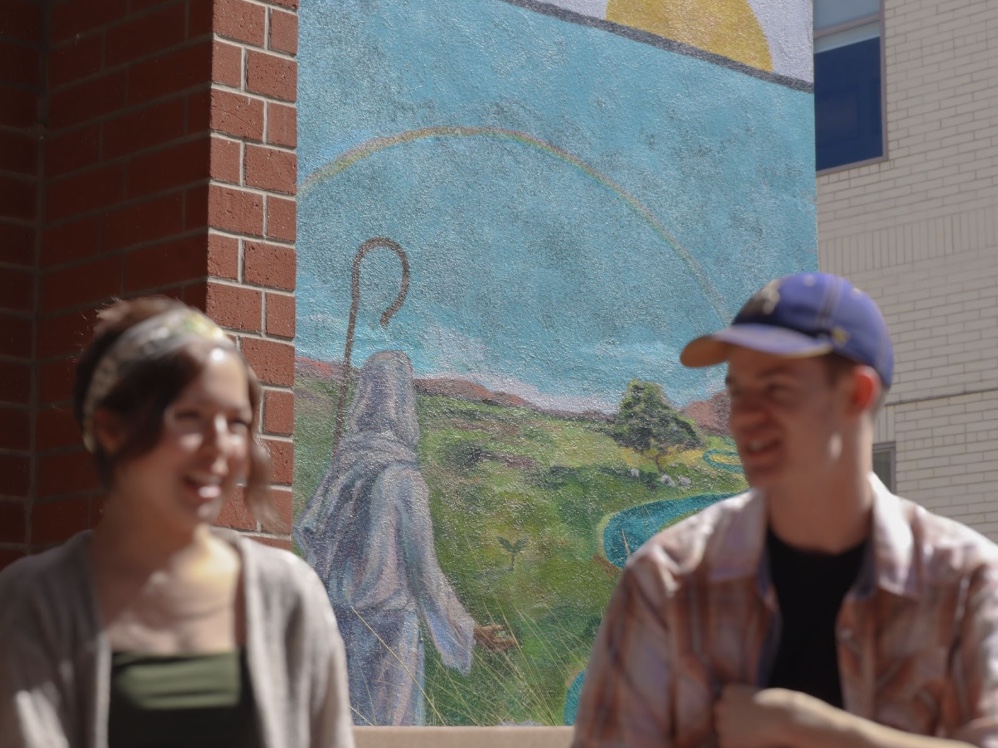
Students graduating with debt after a Biola University education. | Photo Illustration by Job Ang/THE CHIMES
When senior film major Hannah Roberts walks across the stage and accepts her diploma on May 28, reality will hit just four days later. That’s when the first payment of her Stafford loan is due.
Student loans weigh heavy
For the approximately 650 undergraduate students walking this May, the reality of student loan debt is slowly sinking in. Roberts, who expects to graduate with about $20,000 in student loan debt, is actually graduating with less debt than the average student with debt. In 2009, 76 percent of Biolans graduated with debt, according to the Project on Student Debt. Of that number, the average debt was $26,555. That means that the average student in 2009 graduated with approximately the equivalent of one year’s worth of tuition to pay off, since tuition cost $26,424 in the 2008-2009 academic year. Moreover, given the starting salaries of most Biola graduates from fall 2009 and spring 2010, many students are graduating with what is known as “unmanageable” debt, or payments that exceed 8 percent of their monthly income.
For Roberts, the reality of her debt and financial obligations didn’t really hit until after she came to Biola, when her family became less and less able to support her financially. This semester, she was completely on her own.
“It is scary, and I keep thinking back to when I first got to school and went, ‘Oh yeah, I’m going to work this out better than anyone has ever done before,’” said Roberts, whose six-month loan deferment ends in June because she is a part-time student this semester. “I think there’s a part of everybody that kind of goes, ‘Secretly, I have this figured out better than anyone does.’ And then when that doesn’t happen I think is when we start freaking out.”
But, Biola is far from alone in terms of student debt, and not too far off from numbers nationally. By 2008, the average debt level for a graduating senior with student loans in the United States had risen to $23,200, according to the Project on Student Debt, an offshoot of the Institute for College Access and Success. For private institutions, that number was $27,650 — just slightly higher than at Biola. In California, 48 percent of graduating seniors had debt, the average of which was $17,326.
Biola is slightly ahead in employment numbers
For students like Roberts, much of the financial uncertainty is job-related. Roberts, at least, has a part-time job to fall back on, she said. But she knows that isn’t enough to last forever. Of students who graduated in fall 2009 and spring 2010, just 31.5 percent of them had jobs, according to the most recent senior survey from Career Development.
While that number may seem uncomfortably low, it’s ahead of the national average for graduating seniors. According to the National Association of Colleges and Employers, a widely recognized resource for research on employment issues, just one-quarter, or 24.4 percent, of 2010 graduates who applied for jobs had jobs waiting for them at graduation.
Starting salaries and the repayment process
Some students will be graduating with far less than $26,555 in debt, while some will graduate with far more. In the most recent senior survey, 39 percent of students were graduating with $10,000 in student loans or less, while 11 percent were graduating with $60,000 or more. Approximately 28 percent of students were graduating with no debt at all.
But the rubber hits the road when graduating seniors’ low salaries are taken into account in the loan repayment process.
Over the course of 10 years at a 6 percent interest rate (approximately the average rate for subsidized federal Stafford loans over the past few years), an individual with $26,555 in debt and who has taken four years to graduate would eventually pay $35,378.01 dollars to repay student loans, and the interest alone would amount to $8,823.01. Paying off such a debt translates to payments of $294.81 for 120 months (or 10 years).
To comfortably make payments that wouldn’t exceed 8 percent of his or her income, the threshold past which many loan companies and the American Council on Education deem “unmanageable” debt,” that individual would need to make an annual salary of at least $44,221.50.
Paying more than 8 percent is certainly possible. According to calculations by FinAid, a resource for student scholarships and loans, an individual with that amount of debt on a 10-year payment plan could still possibly live and make payments off an annual salary of $35,377.20.
Given 2010 sampling numbers, however, a graduating senior boasting a starting salary of $35,377.20 would be in approximately the top quarter earning bracket of students who obtained a job by graduation, according to Career Development. That means that approximately three-quarters of students who had lower starting salaries under that $35,377.20 mark. An individual who made a full $44,221.50 would be in approximately the top 13 percent of seniors.
Metzger recognizes tuition woes
Those in the upper corridors of Metzger are painfully aware of the strains debt places on students, and that the $24,805,413 that Biola shelled out in institutional aid for 2008-2009 — according to the university’s 990 tax form — simply isn’t enough to compensate the disparity between students’ ability to pay and the tuition price tag. The President’s Administrative Council, Corey’s key team of vice presidential advisers, is aware of that very real gap.
“The PAC recognizes that college affordability and the resulting debt that students take on is a national and Biola University issue,” said Michael Pierce, vice president for business and financial affairs, in a statement. “In the past year a comprehensive study of the problem has been undertaken by a cross functional team of individuals committed to finding solutions. A list of proposed solutions is being put forward at this moment for further discussion and feedback. As some of these solutions are implemented, it is anticipated that a Biola education will become more affordable, thus reducing student debt levels. It is, however, a complex problem with no easy or immediate answers.”
Rick Bee, senior director of alumni relations, said the commissioned Affordability Task Force is really seeking to help students. Bee, who often sees former Biola students who are still working on paying back their debt, said he has students currently in his Faith and Money class with up to $130,000 in student loan debt. The class specifically teaches students how to view and handle finances from a distinctly biblical perspective of stewardship. Bee expressed concerns about students leaving Biola with such heavy financial burdens.
“That debt percentage continues to increase,” he said.
Biolans’ debts are average
Biola falls almost perfectly into the average numbers for schools within the Council for Christian Colleges and Universities. According to Toy Houghton, director of student financial aid services at Houghton College and chair of the CCCU’s Financial Aid Administrators Commission, the average CCCU graduate was $27,375 in the red upon graduation. Houghton said the percentage of graduates from CCCU schools who borrow has remained relatively consistent in the past nine years, hovering around 75 percent.
California Baptist University, considered one of Biola University’s peer institutions, graduates students with notably more debt than Biola does. Eighty-nine percent of CBU’s class of 2009 graduated with debt, and the average debt load was $34,650, according to the Project on Student Debt. Hope International University had just a slightly lower average debt, its average debt number for students graduating in 2009 resting at $27,000. Almost all graduates, however (97 percent), graduated with some level of debt, compared to Biola’s 76 percent.
California actually placed 44th in the nation for student debt with an average 2009 graduating senior leaving with $17,326 in debt. That means the vast majority of states graduate students with more debt than California.
This article is part one of a three-part series. Check back next week to read part two.






